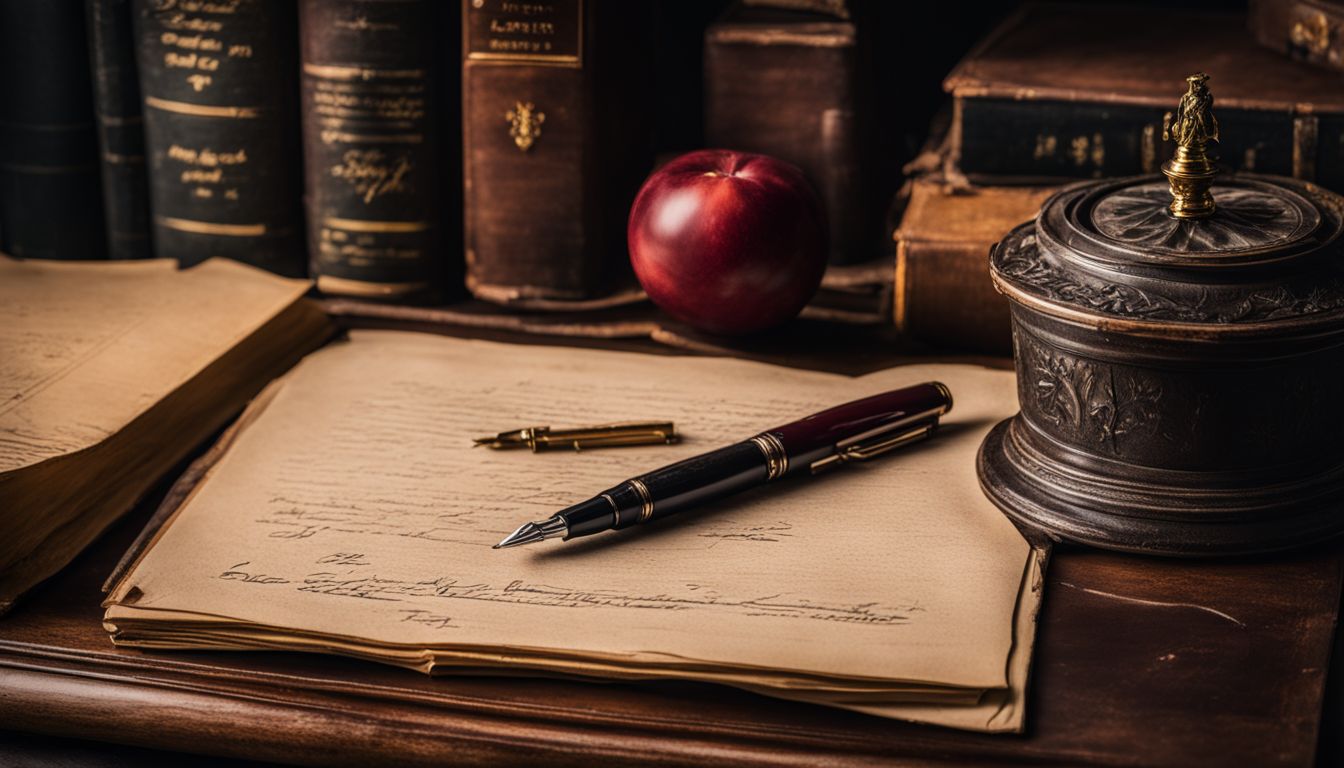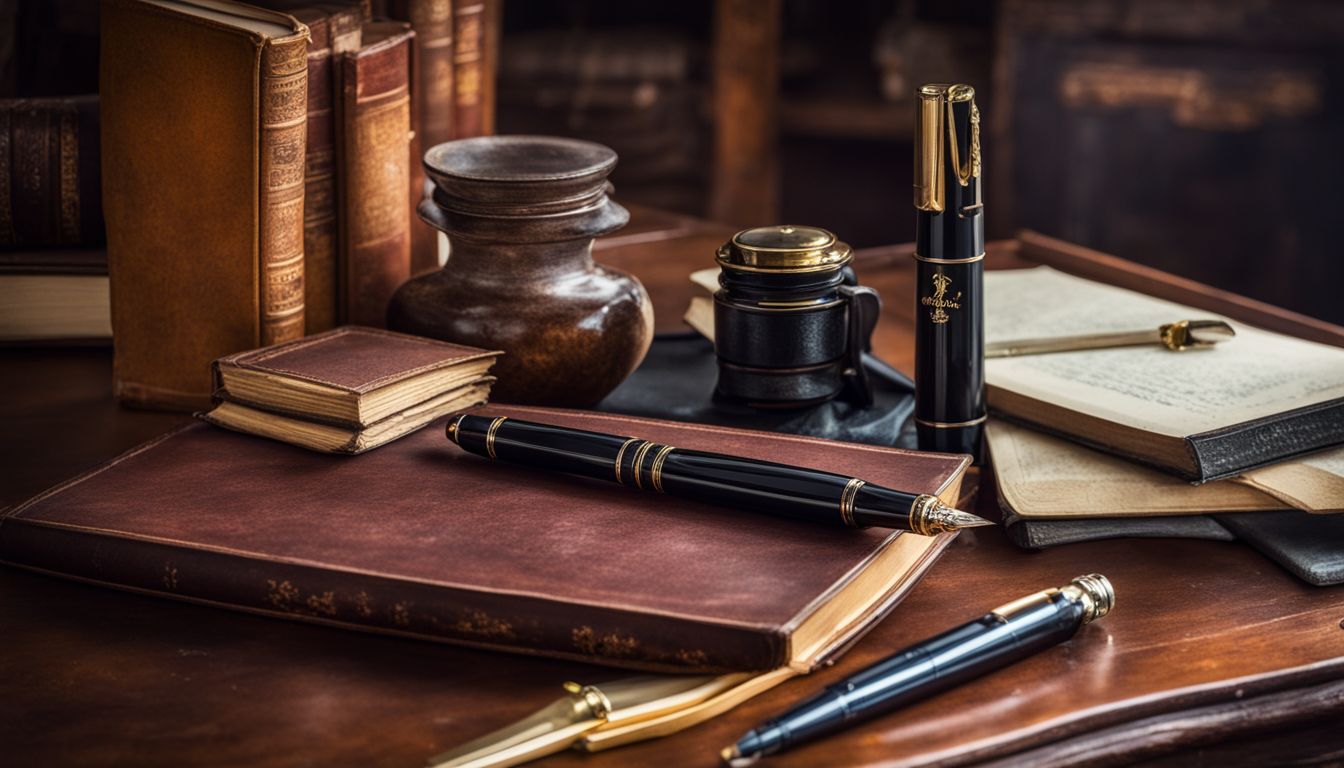Understanding the tools that shaped history’s greatest minds can inspire our own creative pursuits. Albert Einstein, a name synonymous with genius, relied on a trusty fountain pen to draft his revolutionary ideas.
This article will delve into the specifics of Einstein’s chosen writing instrument and its influence, providing you insight into the pen that helped script some of science’s most groundbreaking work.
Read on to discover this iconic tool which goes beyond mere writing.
Key Takeaways
- Albert Einstein preferred the Waterman Taper – cap and possibly the Pelikan 100N fountain pens, which were essential for his scientific work.
- The Waterman pen used by Einstein is displayed at the Boerhaave Museum in Leiden as a testament to its role in history.
- Einstein’s fountain pen was more than a writing tool; it symbolized clear communication and was part of creating groundbreaking theories.
- Collectors value pens linked to Einstein, seeking a piece of his genius. His choice reflects an appreciation for precision akin to his own scientific contributions.
- The Montblanc Albert Einstein Limited Edition Fountain Pen honors Einstein’s legacy with design elements like ‘Einsteinium’ engravings and is limited to 3,000 pieces worldwide.
Albert Einstein: The Genius and His Writing Instrument
 Albert Einstein, the genius behind the theory of relativity, chose a fountain pen as his writing tool. The famed physicist preferred this pen to a simple wooden pencil for jotting down equations and concepts that changed our understanding of the universe.
Albert Einstein, the genius behind the theory of relativity, chose a fountain pen as his writing tool. The famed physicist preferred this pen to a simple wooden pencil for jotting down equations and concepts that changed our understanding of the universe.
Among his possessions was a Waterman’s #20-series eyedropper pen with a sleek tapered cap—a favorite for its reliability and smooth ink flow.
His choice reflects not just personal preference but also the era’s technology; fountain pens were essential tools for scientists in the early 20th century. This particular pen, linked to numerous groundbreaking works including studies on quantum theory and nuclear processes, is now showcased at the Boerhaave Museum in Leiden—evidence of how critical this instrument was to Einstein’s scientific endeavors.
The Significance of Einstein’s Fountain Pen

Einstein’s fountain pen was more than just a tool for writing. It was his partner in developing theories that changed our understanding of the world. With this pen, he wrote letters to fellow scientists like Leo Szilard and Enrico Fermi.
He mapped out the fundamentals of physics, including the general theory of relativity and insights into the photoelectric effect.
This humble instrument witnessed history being made. At Leiden University, Einstein used his pen to share revolutionary ideas with students and colleagues like Paul Ehrenfest. The very same pen now rests in a museum, telling a silent story of intellectual breakthroughs that still shape science today.
It serves as an icon linking Einstein’s brilliant mind with his tangible actions – each letter penned contributing to legacies we remember over time.
Details of Einstein’s Fountain Pen
Unveiling the intricacies of Einstein’s trusted fountain pen reveals not just a tool for writing, but a silent confidant to his greatest thoughts—a narrative you won’t want to miss.
Pelikan 100N
The Pelikan 100N is a classic fountain pen that may have been one of Einstein’s choices. This elegant writing instrument boasts a sleek, black body and a distinctive green ink window.
It’s known for its smooth steel nib that glides across paper with ease. Fans of the Pelikan brand treasure the 100N for its durable design and exceptional writing quality.
Einstein could have appreciated the Pelikan 100N’s reliable performance for his scientific work. The pen combines form and function, making it an ideal tool for someone who valued precision in every aspect of life.
Next up is another contender, the Waterman Taper-cap, which also reflects style and functionality fitting for a genius like Einstein.
Waterman Taper-cap
Moving from the elegant Pelikan 100N to another of Einstein’s trusted tools, we find the Waterman Taper-cap. This unique fountain pen holds a special place in history and is now treasured at the Boerhaave Museum in Leiden.
Einstein gifted this pen to his friend Paul Ehrenfest, who later donated it for public display. Unlike modern pens, the Waterman Taper-cap was an eyedropper fill pen with a distinctive long cap that tapered down—a design feature not commonly seen today.
Known for its quality and durability, Frank D. Waterman’s creation became a part of scientific history through Einstein’s use. The museum ensures that visitors can see up close one of the instruments used by Einstein as he changed our understanding of physics and the fundamental properties of matter.
Even without fancy features or embellishments like mother of pearl, this pen stands out because it was chosen by a genius mind at work—scribbling formulas like E=mc2 that would shape modern science forever.
The Story Behind Einstein’s Fountain Pen
Einstein had a favorite pen, the Waterman Taper-cap. He cherished it not just for writing but as a tool of thought. His fountain pen was more than an instrument; it was his companion in unraveling the secrets of the universe.
Each stroke on paper captured his groundbreaking ideas, including the famous E = mc^2.
One day, Einstein decided to part with this treasured pen. He gave it to a dear friend and trusted colleague as a sign of deep respect and friendship. The Waterman Taper-cap became more than an object—it turned into a symbol of intellectual connection and shared passion for discovery among pioneers of science.
This gesture showed Einstein’s generous spirit and recognition that ideas were meant to be shared for greater good.
The Influence of Einstein’s Pen Choice
Einstein’s choice of pen showed his preference for quality and functionality. The Waterman Taper-cap, which he gave to Paul Ehrenfest, had a significant impact. It was not just a writing tool; it symbolized the great thinker’s commitment to clear communication.
This same pen played a role in drafting scientific theories that changed our understanding of the world.
Fans and collectors now chase fountain pens associated with Einstein, hoping for a touch of genius in their grasp. His use of sophisticated pens like the Pelikan 100N suggests an appreciation for precision engineering—a reflection of his own groundbreaking work in physics.
Next up, let’s dive into how today’s Montblanc Albert Einstein Limited Edition Fountain Pen pays homage to this legacy.
The Modern Interpretation: Montblanc Albert Einstein Limited Edition Fountain Pen
Einstein’s choice of pen has sparked a legacy that blends tradition with modern luxury. The Montblanc Albert Einstein Limited Edition Fountain Pen is a fine example of such craftsmanship.
This pen captures the spirit of one of history’s greatest minds through its thoughtful design and high-quality materials. It boasts a solid gold nib, perfect for smooth writing just like the genius would have appreciated.
Engravings represent ‘Einsteinium,’ an element named after Einstein, adding scientific flair to this writing tool.
Montblanc ensures exclusivity with only 3,000 pieces available worldwide. Each fountain pen in this series serves as more than just a writing instrument; it’s a collector’s item and tribute to an extraordinary individual.
Owners will not only enjoy its functionality but also relish in being part of a limited group who can call this special edition their own. Dive into Executive Essentials catalog for more exceptional pens that share the stage with Montblanc’s masterpiece dedicated to Einstein.
A Look at Other Notable Fountain Pens in History (Link to Wality Fountain Pen article)
Fountain pens have had a long history of being the writing tool for many famous individuals. Their unique designs and links to important events make them memorable.
- Leonardo da Vinci used a quill pen for his artistic and scientific works. His handwriting slants from right to left, showing he was likely left-handed.
- Queen Elizabeth I favored an elegant, jeweled fountain pen. She signed many historic documents with it during her reign.
- Mark Twain was known to prefer fountain pens. He was the first well – known American author to do so in public.
- Winston Churchill wrote speeches with a Conway Stewart fountain pen. This brand became associated with Britain’s wartime leader.
- Mahatma Gandhi received a fountain pen from an admirer. He used it for correspondence and drafting articles.
- The Parker 51 is considered by some as the most popular pen of the 20th century. It was chosen by numerous business professionals and writers for its reliability.
- John F. Kennedy always carried a fountain pen. He signed important legislation with his preferred pen, often a Montblanc or a Parker.
- The Wality Fountain Pen remains popular in India today. It offers quality writing at an affordable price, keeping the tradition of fountain pens alive.
Conclusion
Albert Einstein chose pens that matched his brilliant mind. His favorites were the Pelikan 100N and Waterman Taper-cap. These pens helped draft theories that changed our world. Today, the Montblanc tribute pen honors his legacy, even featuring a golden nib with ‘Einsteinium’.
Imagine holding one of these pens – it’s like touching history itself!
Discover the rich heritage of another classic writing instrument by exploring the history of Wality fountain pens.
FAQs
1. What kind of pen did Einstein prefer for his work?
Einstein reached for a Waterman’s #20-series pen when he wanted to jot down scientific ideas and equations like e=mc2.
2. Can I see Einstein’s handwriting anywhere online?
Sure! You could use Google Translator to look at digital copies of his notes where you’ll spot his unique chemical symbols and the famous e=mc2, or check out message boards dedicated to handwriting analysis of historical figures.
3. Why is it interesting to know about Einstein’s fountain pen?
Learning what fountain pen Einstein used adds a personal touch — it shows us not just how he thought, but also how he put those groundbreaking thoughts on paper. Plus, who wouldn’t want to connect with a genius through something as simple as their choice in writing tools?
4. Did the type of fountain pen affect Einstein’s work in any way?
Well, while we can’t say for sure that his Waterman’s #20-series influenced his theories, imagine if that reliable pen helped him sketch out early concepts for inventions like the refrigeration system – now that’s something worth pondering!




Leave a Reply
You must be logged in to post a comment.